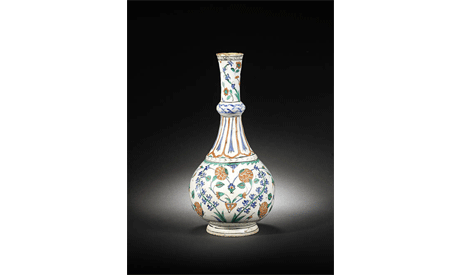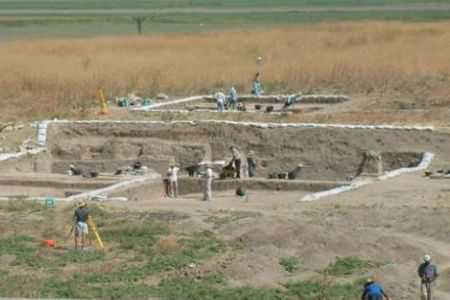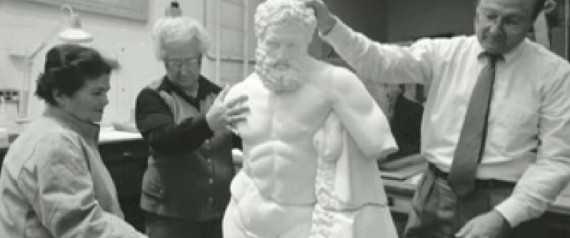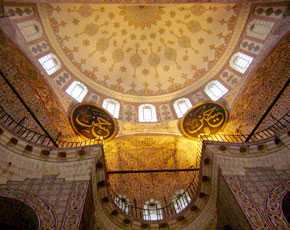A 16th century Iznik bottle flask from a private Belgian collection, linked to Egypt’s presidential palace is one of the top items in Bonhams auction of Indian and Islamic art on 4 October
Bonhams, Saturday 27 Aug 2011

A 16th century Iznik bottle flask from a private Belgian collection is one of the top items in Bonhams’ next sale of Indian and Islamic art on 4 October.
The flask comes from the family of the man whose company was commissioned to build the Heliopolis Palace Hotel in Egypt, which later became the Presidential Palace of recently-deposed Egyptian president Hosni Mubarak. It is estimated to sell for £60,000-80,000 ($97,000 – $130,000).
Iznik pottery and tiles have long held a special place in the minds and hearts of European collectors. The town itself lies in the Marmara region of Turkey and for 200 years, between the 15th and 17th centuries, was the major centre of ceramic production for the Ottoman Empire. Within the lexicon of shapes and types of this highly-regarded pottery, the bottle flask is held in particular esteem. Examples exist in the Calouste Gulbenkian Museum in Lisbon and in the Sadberk Hanim Museum, Istanbul but have appeared on the market very rarely.
This wonderful flask will be offered for sale on 4 October from the collection of Madame Tibbaut, formed by her family who lived in Egypt at the turn of the century. Her great grandfather, Leon Rolin (1871-1950), nicknamed “The Lion of Cairo,” was the owner of contracting firm Leon Rolin & Co, one of the two largest civil contractors in Egypt. The firm was charged with construction of the Heliopolis Palace Hotel, later the presidential palace of the Mubarak administration.
The Heliopolis Palace Hotel was an ambitious project, built in the open desert between 1908-1910, and opening as Africa’s most luxurious hotel on 1 December 1910. It was in these somewhat unusual circumstances that his wife, Madeleine Shaar (1876-1954), started a collection of Islamic art. His daughter Jacqueline continued to avidly collect and was present at the auction of the contents of the Royal Palace of King Farouk. She later returned to Belgium and distributed her rich collection amongst her children and their descendants.
This important Iznik water bottle, made in Turkey around 1575, has a bulbous body with a brilliant white ground painted with red carnations and blue hyacinths.
Alice Bailey, head of Indian and Islamic Art at Bonhams, comments, “It is a lovely piece with a fascinating connection to collecting and industry at the turn of the century.”
In mid-15th century, the Ottoman Turks finally conquered Constantinople (Istanbul) and under their rule Turkish ceramics really came of age. As the Ottomans became more powerful, they employed scores of ceramic artists to make breathtakingly beautiful items for the pleasure of the Sultan and his court. The main development of Iznik pottery is said to have taken place during the second half of the 16th century, after the 1514 capture of the city of Tabriz by the Ottoman Sultan in the Battle of Chaldiran. The ceramic artisans of Tabriz were forcibly relocated to Iznik to practice their techniques.
Iznik vessels were made in imitation of Chinese porcelain, which was highly prized by the Ottoman sultans. The originality of the potters was such that their use of Chinese originals has been described as adaptation rather than imitation.
Chinese ceramics had long been admired, collected and emulated in the Islamic world. This was especially so in the Ottoman court and the Safavid court in Persia which had important collections of Chinese blue-and-white porcelain. Such Chinese porcelains influenced the style of Safavid pottery and had a strong impact on the development of Iznik ware.
Important collections of Iznik ceramics are held in the British Museum, The Victoria and Albert Museum in London, the Calouste Gulbenkian Museum in Lisbon, the Benaki Museum in Athens, the David Collection in Copenhagen and numerous private collections worldwide.
* Bonhams, founded in 1793, is one of the world’s oldest and largest auctioneers of fine art and antiques.
via 16th century Turkish flask with links to Egypt’s presidential palace to be auctioned by Bonhams – Visual Art – Arts & Culture – Ahram Online.





